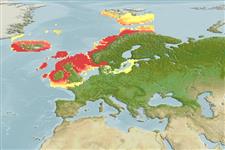>
Gadiformes (Cods) >
Gadidae (Cods and haddocks)
Etymology: Trisopterus: Greek, tris = thrice + Greek, pteron = wing, fin (Ref. 45335).
Environment: milieu / climate zone / depth range / distribution range
Ecologia
marinhas bentopelágico; oceanódromo (Ref. 51243); intervalo de profundidade 50 - 300 m (Ref. 54932), usually 100 - 200 m (Ref. 54932). Temperate; 79°N - 48°N, 27°W - 30°E (Ref. 54932)
Northeast Atlantic: southwest Barents Sea, sometimes at Bear Island, south to the English Channel, - and the Bay of Biscaye (Ref. 90172)-, around Iceland and Faeroe Islands.
Comprimento de primeira maturação / Tamanho / Peso / Idade
Maturity: Lm 14.0, range 11 - 15 cm
Max length : 35.0 cm TL macho/indeterminado; (Ref. 1371); common length : 19.0 cm TL macho/indeterminado; (Ref. 4645); idade máx. registrada: 5 anos (Ref. 273)
Espinhos dorsais (total) : 0; Espinhos anais: 0. Gray-brown dorsally, silvery on sides, white on belly. A dark blotch is at the upper edge of the pectoral-fin base.
Benthopelagic to pelagic over muddy bottoms. Mostly found between 100 and 200 m. Feeds mostly on planktonic crustaceans (copepods, euphausiids, shrimps, amphipods) but also on small fish and various eggs and larvae (Ref. 1371). Caught mainly for reduction to fishmeal (Ref. 3383), trout pellets, fodder (Ref. 35388).
Oviparous, sexes are separate (Ref. 205). Migrates for spawning between the Shetland Islands and Norway and out of the Skagerrak. Major spawning grounds are Northwestern Scotland, Norway, Faeroe Islands and Iceland.
Cohen, D.M., T. Inada, T. Iwamoto and N. Scialabba, 1990. FAO species catalogue. Vol. 10. Gadiform fishes of the world (Order Gadiformes). An annotated and illustrated catalogue of cods, hakes, grenadiers and other gadiform fishes known to date. FAO Fish. Synop. 125(10). Rome: FAO. 442 p. (Ref. 1371)
Status na Lista Vermelha da UICN (Ref. 130435)
Ameaça para os humanos
Harmless
Uso pelos humanos
Pescarias: altamente comercial
Ferramentas
Relatórios especiais
Baixar XML
Fontes da internet
Estimates based on models
Preferred temperature (Ref.
123201): 5.9 - 10.1, mean 7.8 °C (based on 185 cells).
Índice de diversidade filogenética (Ref.
82804): PD
50 = 0.5625 [Uniqueness, from 0.5 = low to 2.0 = high].
Bayesian length-weight: a=0.00603 (0.00527 - 0.00689), b=3.06 (3.02 - 3.10), in cm total length, based on LWR estimates for this species (Ref.
93245).
Nível Trófico (Ref.
69278): 3.2 ±0.0 se; based on diet studies.
Resiliência (Ref.
120179): médio(a), tempo mínimo de duplicação da população 1,4 - 4,4 anos (K=0.36; tm=2.3; tmax=5; Fec=27,000).
Prior r = 0.50, 95% CL = 0.33 - 0.75, Based on 3 full stock assessments.
Fishing Vulnerability (Ref.
59153): Low to moderate vulnerability (32 of 100).
Climate Vulnerability (Ref.
125649): Moderate vulnerability (41 of 100).
Nutrients (Ref.
124155): Calcium = 73.1 [20.9, 258.1] mg/100g; Iron = 0.802 [0.170, 3.524] mg/100g; Protein = 17.9 [15.4, 20.0] %; Omega3 = 0.627 [0.304, 1.293] g/100g; Selenium = 17.5 [8.3, 34.9] μg/100g; VitaminA = 25.5 [6.3, 108.2] μg/100g; Zinc = 1.25 [0.31, 3.42] mg/100g (wet weight);
